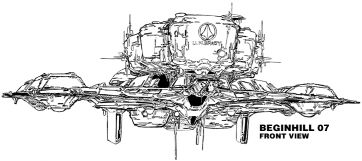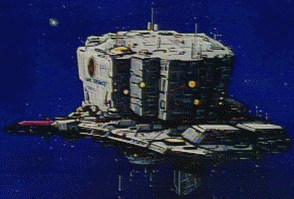 | Mobile Training And Command Centers. |  | |||||
|---|---|---|---|---|---|---|---|
Barring injury or death in combat, the average career of a UGC military member is expected to last somewhere between 10 and 15 years. This poses a serious problem for deep space colony
BEGINHILL-Class ships are complete self-contained TRACEN's. The central hull of the vessels contain dormitories for cadets and barracks for enlisted, classrooms, lecture halls and simulators while the "wings" of the ships contain four enclosed biospheres simulating different types of terrain, from a parade grounds and athletic fields to dense jungles and forests. A typical military career begins with a rigorous 6-week basic training course, typically followed by specialization courses that can take anywhere from 4 to 6 months for enlisted personnel, and full 4 year colleges for cadets. In Wartime the time it takes to train new recruits can be reduced up to 50%, though such accelerated courses are much more stressful on the trainees and produces an "inferior" product than proper training programs. (The 6-wk officer Basic Training Program remains the same, but the 4-yr program is cut to 2-yr.) BEGINHILL-Class vessels can train recruits for any UGC military profession, from infantry and Boatswain's Mate/Machine Keeper to VF pilot and Ships Command. (Though it would be a surprise to some, the Spacy/Patrol's Boatswain's Mates/Machine Keepers and the Army/Marine's Infantry are the most MOST critical of occupations in the UGC militry; Without these three groups, the whole system would grind to an absolute halt in six months, and would never be able to fully recover.) The ships also conduct refresher courses and continuing/advanced training for all branches of the military. Every military officer on a UN Spacy colony mission is required to spend at least 2 weeks per year aboard a BEGINHILL vessel, where they are educated in the latest advances and tactics from UGC/REF Militry Headquarters on Optera (enlisted personnel are sent on an as-needed basis). In an emergency, the BEGINHILL-Class vessels are also capable of acting as the command and control center for a colony fleet if the fleet's Command Ship (typically a Megaroad-Class Colony Ship) is lost. BEGINHILL-Class ships are equipped with advanced sensor suites equivalent to those found on any other militry vsl. The center of the ship contains a large multi-level situation room that is constantly staffed and maintained during Wartime in case of an emergency. BEGINHILL-Class vessels also contain powerful communication suites with military-grade encryption and ECCM capabilities, providing a constant communications link between the colony ships as well as secure communications back to UGC Militry High Command Headquarters. Like most other colony ships the BEGINHILL vessels are largely unarmed and must rely on an ARK ROYAL-Class Escort Battle Carrier docked at the bow of the ship for protection. However due to the sensitive military nature of the vessels they are almost always assigned an escort fleet of 6 to 12 proper combat ships for protection. In addition the large hangar bays onboard the BEGINHILL-Class ships can carry up to 20 squadrons of VFs and other fighters. Although primarily used for training, these squadrons can be fully equipped for battle with only a few hours of Warning. BEGINHILL-Class ships have proven very successful in the field and produce 90% of the UGC's new personnel every year; 50% of the militry's civilian employees even receive their training on these vsls. They are crucial to the UGC's overall colonization strategy, as well as ensuring the safety of citizens out on the fringes of known space. Every UGC colony mission in service today has 1-3 BEGINHILL-Class vessels assigned to it (depending on fleet size), and there are no plans to replace or retire these vessels at any time. An interesting note it the hull history of the vsls; The namesake, UES BEGINHILL herself, was a Robotech Factory recovered, largely intact, after being abandoned somewhere around 1,000 years before. Her conversion to a TRACEN was accidental; She had been abandoned in the Azumption System not due to damage, loss of Protoculture, or occupation by the Invid, nor any other condition "requiring" abandonment, but because the asteroid she was rending down apparently was NOT as rich in iron (a critical mineral) as expected, and another factory needed the personnel. The ship was intended to be re-occupied, but she was simply lost in the shuffle. The REF simply occupied her at the time solely to control her movement, to ensure she didn't stray into spacelanes. The survivors of the Tirol Campaign were transferred there, then some enlisted n the REF; They had to be trained, so part of the ship was converted. As more Sentinel and Allied Worlds (such as Fljyt) were liberated, more enlistees poured in. So on it went, until the ship was formally re-designated a TRACEN, converted fully to those duties, and christened BEGINHILL (she had not, before that, apparently had a name, though this is in debate). UGC-aligned systems also have these vsls, as do some colleges (GS St Gertrude Medical College is a roving medical school completely contained in a BEGINHILL-Class, for example). Government: United Galaxies Council. Ship Type: Mobile Training Center. Class: BEGINHILL-Class. Crew (not including Escort Carrier): 50,000 total. Military Crew: 3,500. Civilian Crew: 500. Instructors/Staff: 2,000. Recruits/Trainees: 40,000 (average). Military Police: 1,000. Permanent Civilian Populace: 3,000. MDC By Location: | |||||||
| * Main Hull ** Upper Habitat Section *** Main Communications Cluster Outriggers (2) Biospheres (2 per outrigger, 4 total) Connection Joint to Escort Carrier Engineering Sections | 200,000 100,000 5,000 50,000 each 5,000 each 4,000 20,000 each | **** Main Engines/Power Plant (4) **** Auxiliary Engine (1) Small Airlocks/Access Hatches (200) Main Hangar Bay Door (1) Outer Hull (per 40ft area) Interior walls (per 20ft) ***** Pin Point Barriers (4) | 50,000 each 15,000 each 250 each 1,000 120 40 5,000 each | ||||
| Notes: * Depleting the MDC of the main body will essentially destroy the vessel. All internal systems will shut down, including life support and internal gravity. The ship itself will be an unsalvageable floating wreck, and any surviving colonists must be rescued quickly or will die from asphyxiation as the remaining atmosphere drains into space. ** The upper habitat section contains most of the dormitories and training facilities, as well as the habitation areas. Destroying this area will result in the deaths of 90% of the trainees and civilian populace. In addition, the damage to the main vessel will be so great that all systems will fail within 2D6 minutes. The main communications cluster will also be lost. *** Depleting the MDC of the communications cluster will deprive the ship of long range/hyperspace communications, radar and subspace sensors. Backup sensors and communications will give the ship detection and communication capabilities equivalent to a Northampton frigate. Note: The command center for the Beginhill ships is built deep within the hull of the vessels. It can only be destroyed by depleting the MDC of the main body of the vessel. **** Depleting the MDC of the main engines will force the ship to rely on its auxiliary engine. Depleting the MDC of the main engines AND auxiliary engines will leave the vessel adrift in space. If in an atmosphere, the ship will crash (destruction of the main engines will render the antigravity system useless due to loss of power). ***** If destroyed, a pin point barrier will completely regenerate within fifteen seconds (1 melee round). See the Pinpoint Barrier System entry for details. Speed and Statistical Data: | |||||||
| Speed (sublight): 0.16 speed of light (25,600 miles per second) Speed (Auxiliary Drives): Mach 3 Space Fold Range Unlimited (1 light year every 6 minutes) Planet bound: Designed to land when necessary but not designed to maneuver in an atmosphere. Maximum Range: Unlimited (estimated 30 year life span) Length (excluding Escort Carrier): 24,600 ft (7,500 m) Clearance: 17,700 ft (5,400 m) Beam: 20,000 ft (5,400 m) | Weight: Approximately 331,500,000 tons standard Power System: ORTEC/General Galaxy Main Reactor. Drive Systems: Primary: ORTEC/Centinel Impulse Drive Cluster. Secondary: Shinnakasu/Shinsei Industries/Agar Nuclear Pulse Rocket Motor Clusters. Cost And Availability: About 30 millioncredit each; Always available. Black Market Cost And Availability: Same; Not much interest. | ||||||
| Weapons Systems: Fairly limited; These are training ships, and therefore rarely are near combat. However, increasing attacks by malconts, especially Atorians, on "soft targets" such as these ships have forced an increasing in the armaments, and the UCG is considering increasing the BEGINHILL-Class with T'sentrædi Laser and Missile Turrets. | |||||||
| 1. Pinpoint Barrier System: Originally developed by researchers onboard UES MACROSS (SDF-001) during the FIRST ROBOTECH WAR, the Pinpoint Barrier System is a standard defense system on board all UGC starships and colony vessels, including the BEGINHIIL-Class Training Ships. The system generates four small disc-shaped force fields that can be positioned anywhere along the ship to deflect missiles, energy beams or projectiles. Each pinpoint barrier is about 200 ft (61 m) in length and can absorb up to 5,000 MD in damage, which then regenerates within fifteen seconds (1 melee round). The barriers can also be layered on top of each other to generate a field which provides 20,000 MDC and can even deflect heavy particle beams (usually). The four barriers are controlled by operators in the center of the vessel. These operators are instructed to defend (1) any breaks or weaknesses in the main hull, (2) the main and auxiliary engines, (3) the engineering section/stealth frigate docking section and (4) any starships under construction, in that order. The operators primarily concentrate on defending the ship against larger spacecraft and leave defense against attacking mecha to the VF pilots from the stealth frigate. Purpose: Defense (the pinpoint barrier system cannot be used as a weapon). Damage Capacity: Can sustain up to 5,000 MD per round. If destroyed, the barrier will regenerate to full capacity in one melee round. Range: Up to 300 feet (91.5 m) from the surface of the vessel. Radius: 200 ft (61 m). Attacks Per Melee: Can move from one end of the vessel to the other in less than a single round. Trained operators can attempt to block attacks up to 8 times per melee (counts as a parry) and are at +7 to block. Untrained characters can parry up to their number of hand-to-hand attacks with their normal parry bonuses only. Payload: Nearly inexhaustible. Will work as long as system is functional (see below) and engines are intact. If main engines are destroyed, the barrier will loose power and not function. Note: If all four barriers are grouped in a single spot they can deflect a heavy particle beam attack, such as the one generated by the Macross Cannon, T'sentrædi Command Ships. However, the beam will completely destroy all four barriers and put incredible strain on the pinpoint barrier system, to the point where it may short out. After deflecting an energy beam, roll percentile dice on the table below to determine additional effects/damage. 01-15: Lucked out, system will be operational in 1D6 hours 16-30: Minor damage, system will require 4D6 hours to repair 31-45: Major damage, system will require 2D6 times 10 hours to repair (yes, DAYS of work). 46-60: Completely destroyed! System can be rebuilt, but will require new parts and 2D6 DAYS of work to replace. 61-75: Major damage, system will require 2D6 times 10 hours to repair. 76-90: Minor damage, system will require 4D6 hours to repair. 91-95: Lucked out, system will be operational in 1D6 hours. 96-00: It's a miracle! Trivial damage only, system will be operational again in only 4D6 melee rounds! | 2. Defensive Laser Batteries (20): Each vessel has 20 defensive laser batteries for anti-missile and meteorite defense. MD: 5D6 per blast. Rate of Fire: Per gunners attacks per melee plus bonuses (generally 4 or 5 per melee). Range: 500 feet. Payload: Unlimited. 3. Ships, Fighters, Power Armor, and Robots: Shuttles- 200 Space, Guardian, and Veritech Fighters- Up to 20 squadrons; A full Veritech Fighter Training Wing is located on each such vsl. Power Armors- Up to 100,000. More Mecha can be carried as well. 4. T'sentraedi Style Heavy Laser (60): An as-yet undetermined number of these batteries may be added to these vsls. MD: 1D4 times 100 per blast. Rate of Fire: Twice per melee. Range: 200,000 miles. Payload: Unlimited. 5. Automated Missile Battery (20): An as-yet undetermined number of these batteries may be added to these vsls. Missile Type: Any MRM or LRM Purpose: Anti-Ship Defense. MD and Range: Varies by type used. Rate of Fire: Twice per melee. Payload: Up to 1,000. 6. Full-Force Barrier System: The UGC has decided a full-force barrier field WILL be installed, but there is a debate as to whether to install the Standard Full-Force Barrier Field developed on UES MACROSS (SDF-001), or the newer Variable Full-Force Barrier Field developed from the Raulon've (Trithruster Pod- Fighter Pod). Damage Capacity: Either 20,000 or 3,500 per feild. Range: About 300 feet from the surface of the vessel. Attacks Per Melee: Only one, really. Payload: Once. 7. Other New Weapons: The UGC has been debating other weaps as well. | ||||||
| Features: | |||||||
|
| ||||||
 | |||||||

